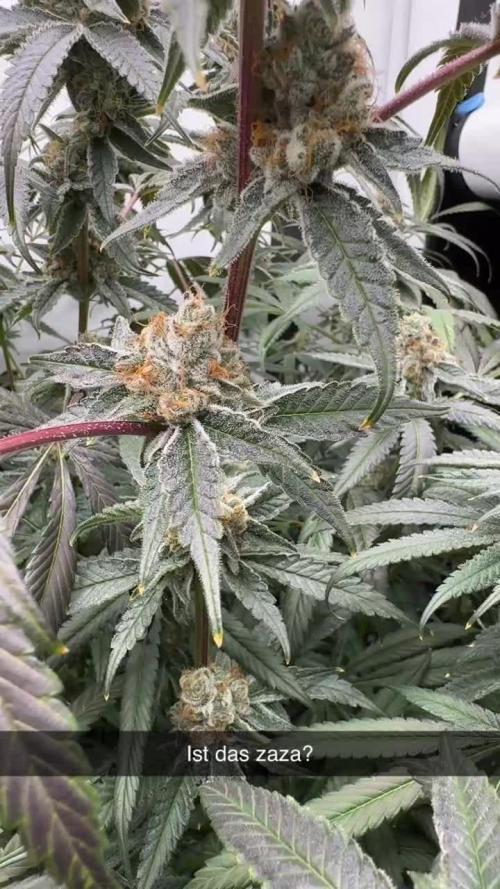The Grow Awards 2026 🏆 

























Likes
Comments
Share


@ApothecAries
Follow
Happy and Healthy.Rehomed into 5 gal fabric pot with Dynomyco. Recieved a top feed of 70/30 Gaia greens. Some worm castings on Day 30 with a dose of beneficial bacteria and teaspoon of molasses.
Day 35 I’ve took before and after photos and spread her apart to get even canopy coverage. Light defoliation. Very healthy girl full of vigour!
Thanks for checking up on the girl!
Likes
12
Share


@ciansta
Follow
So the Northern Lights free seed from RQS ended up out living all 3 of the Dosidos’ “USA Premium” seeds that all died within the first week of sprouting, hopefully an explanation will be found for this as I have not been able to come to any conclusion as to what happened. Long live the lights amiright
Likes
36
Share


@nonick123
Follow
Día 59 (29/07) Este cultivo no es muy entretenido con solo agua, asi que...
Le hago supercropping a todas! 😁 A ver como reaccionan!
Riego 500 ml H2O pH 6,5 SÓLO a OnionOG #1
Día 60 (30/07) Las plantas se están recuperando muy bien del supercropping! 😁
Todos las puntas hacia arriba! 💥
Come onnnnnnn! A por esa floración en 2-3 semanas!
Riego 500 ml H2O pH 6,75
Día 61 (31/07) Las plantas se han recuperado genial del supercropping y están lanzando TODAS las ramas hacia arriba 😍
Un espectaculo la fuerza de estas plantas! 💥
Redistribuyo las plantas, para ver si OnionOG está más protegida del sol, ya que consume muchisima agua y voy a estar en unos días fuera...
También reubico ligeramente la malla de sombreado, debido a que en mi latitud el sol empieza a incidir lateralmente por las tardes...
Riego 500 ml H2O pH 6,55
OnionOG: Riego 1 Litro H2O pH 6,5
Día 62 (01/08) OnionOG me impresiona con su vigor. Sus ramas se están estirando de forma impresionante!
OnionOG le hago una poda de partes bajas de las ramas para mejorar el flujo de aire y que concentre su fuerza en las ramas superiores
Vuelvo a redistribuir las plantas en el invernadero dejando a OnionOG todavía más protegida del sol directo, para tratar de disminuir su consumo de agua estos días que no voy a estar...
Pongo una protección "visual" en el invernadero en el lado que da a los vecinos (cara norte), porque he "cazado" miradas indiscretas...
Riego 500 ml H2O pH 6,55
OnionOG: Riego 1 Litro H2O pH 6,5
Día 63 (02/08) Debido a que me voy de vacaciones unos días, adelanto el riego semanal con Té y la aplicación foliar de Kelp
Riego con 1 Litro de Té Vegetativo de Lurpe Solutions. Preparación: 24 horas con bomba de aire (oxigenación) con ingredientes:
Green Sunrise 8 ml/L + Insect Frass 16 ml/L + Hummus Lombriz 8 ml/L + Melaza 1 ml/L + Kelp Hidrolizado 0,25 g/L
Aplicación foliar Kelp hidrolizado de Lurpe Solutions a 0,25 ml/l
Día 64 (03/08) Cerrado por vacaciones
Día 65 (04/08) Mi amigo viene a casa a hacer un riego con 1 Litro de H2O pH 6,5
💦Nutrients by Lurpe Solutions - www.lurpenaturalsolutions.com
🌱Substrate PRO-MIX HP BACILLUS + MYCORRHIZAE - www.pthorticulture.com/en/products/pro-mix-hp-biostimulant-plus-mycorrhizae
Likes
16
Share


@Rinna
Follow
I’ll update ya’ll on the smells and tastes after drying and curing! So far both are packed with ice and smell very potent, a little overpowering still, so I want to give it some time before they’re cures and can show their true terpene profile!
Likes
19
Share


@AsNoriu
Follow
Day 15. Girls are flying !!! Think on day 18 i will do heavy defoliation, maybe Middle girl will have to be treated differently, she is a bit behind by flower development.
Still see one or two bugs, but today i should get ladybugs from friends shed, they always nest there, but you never know ....
Worst case - this wednesday i will get 200 LadyBug larvas, they should do a deal !!!
Plus, new adventure on horizon ....
FastBuds send me theirs surprise package !!! I know i said never again autos indoors, but this house is just too good not to give a try ! Huge thanks !!! I really will try my best to show beauty of theirs strains !!!
So Future is planed, now just finish those wonderfull Kushes !!!
As you see, my anti-fim'ing worked well on Tallest Kush, other girls managed to save main cola as main, Tallest have it as well, but it shrinked to smallest size and stayed lower than main canopy.
Main stretch is going to the end and after training i will lift Smallest Kush to Middle's level.
Day 15. Update, got like 50 ladybugs. 10 went to this tent, others will go to big one. Still waiting for larvae postage.
Day 16. Heavy training done now : defoliation, lolitoping, watering straight after....
Tallest Kush - 14 tops, amazing, cleared her really high, but it will be 3-4 ounces plant easy, i see structure already, after my version of fim'ing she made 3 tops, where center one shrink to side branch size. Very good structure - thats my target for future grows.
Middle Kush - a bit delayed in flower, but very bushy. After failed attempt of anti-fim'ing all side branches had triple shoots, needed to repeat action most probably ...
Anyway - she will be dofoliated in 4-5 days i think.
Smallest Kush - Midget warrior ;))) She will have hardest nugs from all 3, let's see what size colas she will make, branches shortest, but fatest of all 3.
Day 17. Girls are on absolute max power, looks happy as f@ck and that makes my heart sing !!! ;)))
Day 20. Gave Silica acid with watering. Looks like this tent is free from thrips, girls always prays and drink quick, so its all good in the neighbourhood ;)))
Happy Growing !!!
Likes
35
Share


@Fatnastyz
Follow
1-19
Added 2 ml water to the top where planted, sprayed dome. End of the night see a buldge.
1-20
In the am, still no head, 2ml water, keep the top moist. but starting to show more. by afternoon, w have Runtz1. ( As soon as breaks ground, remove RH Dome.)
Shortly after we have Runtzs 2. She seems to have pulled a leaf off getting her head out. My other told me to scrap her, but I figured she will be fine.
So for the tie break, I called apon @valiotoro . Told him he would be the tie breaker. SHES A KEEPER! 💪
I do not like to give up on any of my girls! 💪
Very excited to get this ball Finally Rolling!
Preparing the Rocket ship, Lift Off Soon!
Someone said, are you sure? There is some big dawgs in it.
Well they better eat their Wheaties EVERY DAY, Fatty is coming! ( Guy Approves this Message 😻)
1-21
250 ml ph 6.0 water. Shes going. Humidifer arrives tomorrow. RH is 30% and temp hovering 70F. Every 2-3 hours I spray the tent walls to help with the RH. Holds between 55-65%.
1-23
Moved to big tent temps everything's normal now.
1-24
Loves her forever home, not pot. Getting 250-260 ppfd. The green mykos is showing on the dirt. All going smooth 💪
Well thats it for week 1. Moves will pick up soon.
Again ty Zamnesia, Plagron and The Eternity Grow Cup
Likes
18
Share


@Coopmc
Follow
Hear we go test growing the new batch of seeds!! So far nice split going on!
7 out of 10 split and planted!!
7 heads popping up!
Likes
2
Share


@AestheticGenetix
Follow
7/8/25 Starting to look very very nice. Some nice purple flakes on the edges of the sugar leaves with bright hairy orange pistils on nice bulbous shaped buds
Likes
1
Share


@EgoDeath
Follow
Really loved this plant and how it grew other then the fox tails, Unfortunately I had to move this weekend and just couldn’t continue growing her and moving at the same time. She still had a good 1-2 weeks left but what is there looks really good will update when she finishes drying.
Processing
Likes
23
Share


@SativaSteve88
Follow
Excited and impatient, starting to come on really well now, everything is going ok as it has been all the way through other than a little struggle with keeping the heat down in the grow tent during the first few weeks in veg, bigger tent and all is ok now, small signs of nutrient burn of a feed this week but don't think anything to be worried about from other diaries i have seen. What do you think its going like so far? Any comments with feedback on how its looking or tips for me coming into my final weeks appreciated thanks,, Plant A is at 121cm tall Plant B is at 143cm tall
Likes
12
Share


@Kardo
Follow
Super Sorte die ich bekommen habe von @skunkydog420 danke nochmal und es sind jetzt 30g trocken aus der Amnesia Haze Auto raus gekommen ich bin zufrieden und sie schmeckt sehr lecker
Likes
6
Share


@captaincondor
Follow
She's doing nicely so far pleased with this pheno the structure is good , sadly she is only getting twelve hours due to photoperiods taking up space
Likes
12
Share


@Kenpowarrior
Follow
●dwarfs have slow down on grow hope the buds will get bigger.🤔
●honeys are getting bigger and more leafes with small signs of flowering.
●no wonder my 12/12 did nothing ...went from 18/6 to 16/8 🤦♂️🏽🤪
●now 17/01/2021 set 12/12 ...from 6 till 18h. 🤦♂️🏽😂👍
●getting pretty white my dwarfs...
●heavy defoliation on 22/1 = more light
●honeys weak and no flowering to see.🤔



























